You’ll find no spa, no speedboats, no haute cuisine at this Provençal auberge called La Colombe d’Or. Instead, you’ll find something much better: the spirit of an era you might have thought extinguished. The walls are set ablaze with artwork that both chronicles and constitutes the story of this rarefied place. But let’s not skip ahead. This story starts in 1920, with one local farmer named Paul Roux.
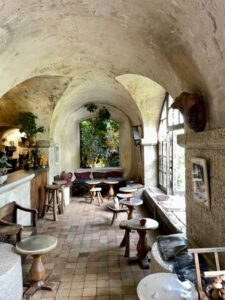
The bar at La Colombe d’Or
Paul and his wife, Baptistine (affectionately, Titine) had the bright idea of starting up a little restaurant in the quiet town of Saint Paul de Vence. They would serve simple food from the area, nestled between Nice and the Alps Maritimes. They added three guest rooms for good measure and were quite content to leave it there.
As it would happen, this was only the beginning of La Colombe d’Or. When war came, there was a mass exodus from the cities. Modern artists took flight to the French countryside, many of them finding shelter from the storm at La Colombe d’Or, in all its sequestered informality. The humble auberge opened its arms to them, expanding to accommodate these new friends. The façade was enlarged using stones from an old castle in Aix-en-Provence and the help of many hands. The Marseillais architect, Jacques Couëlle came aboard, designing a fireplace in his characteristic sculpted plaster style. The finished product wears the handprints of those who helped to build it, making history visible.
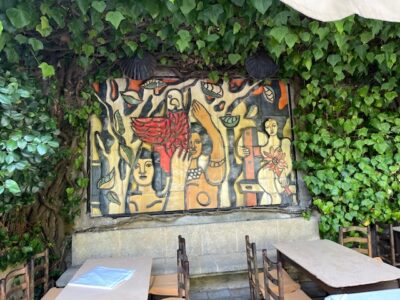
Mural by Fernand Léger
By now, a feeling of camaraderie had set in. There was a sense that this was a living place, always in the making. Fortuitously, the characters milling around La Colombe d’Or were perhaps some of the best makers to be found. They were artists like Pablo Picasso, Henri Matisse, and Fernand Léger. They all left their mark – a painting here, a mural there – and the place began to grow a reputation.
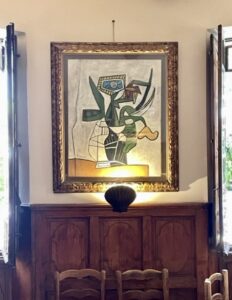
Painting by Pablo Picasso
The area was no stranger to artist colonies, but this was a different sort. This was a little world unto itself where rent need not necessarily take the form of money. And so, they came – those with colours and canvases primed to be spun into payment. Georges Braques left behind his own renditions of the local fauna. Joan Miró paid his way with great golden canvases. Alexander Calder hung a mobile to twist in the breeze above the pool. Truly historic works of art were casually shelled over in exchange for a few meals and a night or two’s rest in these humble rooms.
Visit today and you’ll notice a sign at the entrance which translates roughly to “Here we lodge those on foot, on horseback or with paintings”. You’ll find no formal plaques or labels, no pamphlets or guidebooks. The art that lives at La Colombe d’Or is part of the fabric of the place, and much like a beautifully executed piece of fine furniture or a collectable rug, it requires no plaque to separate and adulate it.
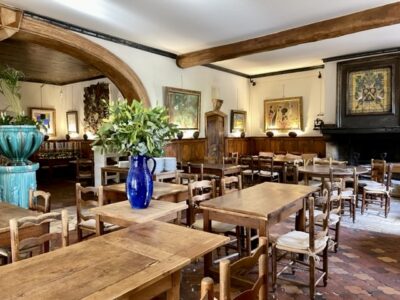
The dining room at La Colombe d’Or
As the art collection grew in size and stature, it began to draw eyes and stir temptation. One morning in 1959 Titine strolled downstairs to find nearly every masterpiece gone – poof. The bandits had conceded one work by Marc Chagall, which was clearly too large to shimmy through any of the windows. As had become his habit, Chagall popped in for lunch later that day and was filled with disappointment at the sight of his painting, hanging in loneliness. He flung his arms in the air, aghast. “I’m a big-time artist!” he said, “Why are you not stealing my paintings, too?” They did eventually recover all of the stolen works, and to save Chagall from future embarrassment, installed a security system.
There were other attempts to own this un-ownable conglomeration of art, history, and spirit. An American tried his hand, offering a vast sum to buy the whole auberge. Paul Roux, ever the gentleman, responded by sending flowers in lieu of a contract. They arrived with a note reading “These flowers are for you – La Colombe is for my son”. He was a man of his word, and La Colombe did pass to Paul’s son, Francis alongside his wife, Yvonne. It’s now under the stewardship of Paul’s grandson, François and his wife, Danièle.
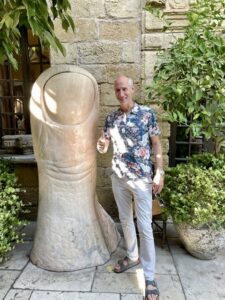
Tom at La Colombe d’Or with a sculpture by César Baldaccini
Tom visited La Colombe d’Or not long ago, enjoying the ephemeral air of creativity infused with that classically French bon vivant spirit. Where it differs from other destinations in the South of France is in its humility and cooperative ethos. It remains a place to see, rather than to be seen. Whether it’s a Picasso or an all but forgotten painter, whether it’s Bono or a local in for a hearty meal – there is no competition here. This is not a place to be someone, but rather, a place to simply be.
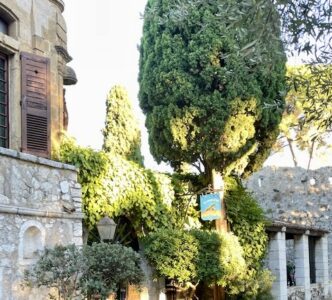
The entrance of La Colombe d’Or
La Colombe d’Or still has fewer than thirty rooms. It has no spa and doesn’t exactly serve haute cuisine. What it has got is charm, history, and critically, some of the world’s great works of art. La Colombe d’Or lifts the veil to expose this place where art and life coalesce. It’s a living museum of the spirit of a time, not just the artworks that were produced by and represent it. Long may it stay just so.
Photos by Tom
Text by Annabel Colterjohn